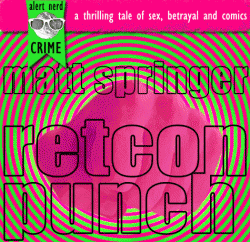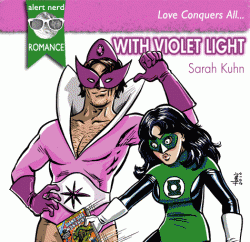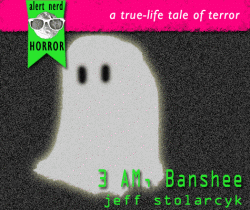Matt’s Adventures with Luther Arkwright
Matt’s Adventures with Luther Arkwright
May 28When I heard about the Fantastic Fangirls‘ May blogging event, What Are You Waiting For?, it wasn’t really a matter of finding something to read or watch that would fill in a critical blank in my geek awareness. It was more a matter of choosing from the seemingly endless list of stuff I still have to consume.
I’ve never read Sandman, Preacher, From Hell, Frank Miller’s Daredevil, or all of Lee/Kirby’s Fantastic Four. I have an uncracked copy of Dash Shaw’s Bottomless Belly Button staring at me guiltily. I’ve never seen Blade Runner, 2001: A Space Odyssey, or even Vertigo. (Yes, I have seen Star Wars too many times to count. SHUT UP.)
In other words, I have a LONG way to go toward feeling fully versed in the essentials and cult classics of geekdom, and I’m the kind of guy who hates feeling like he’s missing out on part of the collective understanding because he hasn’t seen/heard/read something. So lots to do, lots to do.
For this particular opportunity, however, I decided to pick up a book I’ve owned for more than three years and never been able to get into: The Adventures of Luther Arkwright, by Bryan Talbot.
I bought my copy of the Dark Horse collected edition right after I started getting back into comics in 2005; plucked it right out of a $5 trades bin. Warren Ellis had recently talked it up in some forum or another, and the back cover had blurbs from Alan Moore and Garth Ennis, so it seemed like a missing link in the history of modern comics.
It is just that; according to Wikipedia, its initial run appeared in the late seventies in the UK, a prime breeding ground for Today’s Comics Geniuses:
The first parts of The Adventures of Luther Arkwright followed as a serial in the British underground comic Near Myths in 1978, were later continued in pssst! magazine, then interrupted in 1982, less than half complete. Between 1987 and 1989 Bryan Talbot completed the story, which was published as a series of nine standard comic books by Valkyrie Press, followed, at readers’ request, by a tenth issue containing articles about the history and production of the comic and some extended backstory and character information. It was subsequently published in the United States byDark Horse Comics.
In fact, Grant Morrison’s earliest work made its debut in the pages of Near Myths as well.
I say “missing link” because in making my way through it (I’m about fifty pages in, or one-fourth through), there’s a density to the content that seems to owe more to prose science fiction than comics. And yet, it’s undeniably sequential art, and Talbot makes full use of that medium as well; for every lengthy caption or dialogue chunk, there’s a visual twist that shows Talbot is paying just as much attention to what he’s showing as he is to what he’s telling.
The story deals with a wide range of alternate realities, and Arkwright as the key figure able to navigate them all and do battle against the forces of evil; in that sense, it borrows from Michael Moorcock’s Jerry Cornelius cycle of stories, which I also have not ever read (IT’S ON THE LIST PEOPLE). In fact, Moorcock does the introduction to the Dark Horse collection of Arkwright I’m reading right now.
Given these anecdotal connections, it’s tempting to view Arkwright as a connective tissue between the prose and literary advancements of science fiction’s “new wave” and exploring ideas of a comparative complexity using comics. It’s hard to speak to this without a level of contextualization that exceeds my grasp, but to me, Talbot seems to be straining against the artificial “limits” of comics as they were perceived at the time in order to tell a complicated and layered story. Hell, in the window between Arkwright‘s first run and the completion of the story, we’d see Morrison’s Zenith, Moore’s Swamp Thing and Watchmen, and Spiegelman’s Maus, among others; modern comics as we know it was invented and exploited by the time Talbot finished his tale.
In its way, Arkwright was there at the dawn of modern comics, and there to scoop up the turds at the end of the parade. (The first parade, anyway.) And yet, it’s not the easiest read. It’s a text that requires some heavy mental lifting to connect the divergent pieces; dates and times and events may pass by almost undocumented in a short quasi-caption with dateline, or they may be splayed across a painted double-page spread. The reader is left to infer a great deal of the connections between events and characters that make up the overall story. It’s a very Morrisonian approach of putting the pieces out there, focusing on key moments, and relying on the reader to fill in the blanks. It’s not always an approach I enjoy, frankly, though that may owe just as much to my own laziness as a reader as it does to any flaws in the work itself.
But there is always that gorgeous Talbot art, and the inescapable sense that he’s taking a storytelling medium and leveraging its tools in ways that had never really been seen before, at least not in the service of a complex genre tale. The Adventures of Luther Arkwright has history and beauty to recommend it; there seems to be a story there too, if you’re willing to work for it. If nothing else, you’re there as you read it to watch the comics medium explode into tiny pieces and fall together again, not for the first time, and not for the last.











Man, I had never heard of this before but it sounds fascinating. Thanks for the review!
In the interest of full disclosure, I gotta admit I kinda gave up on it last night…just too dense for me and didn’t draw me in. But there’s no denying it’s pretty brilliant so your mileage may vary!